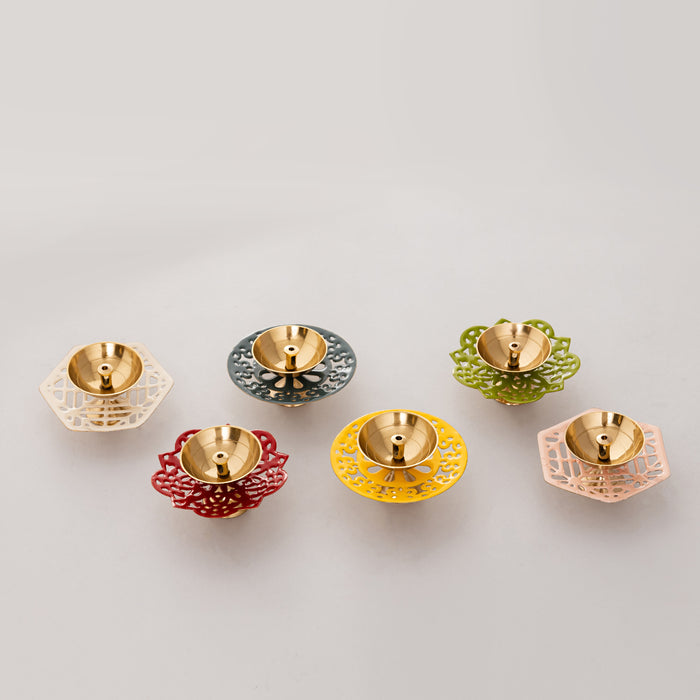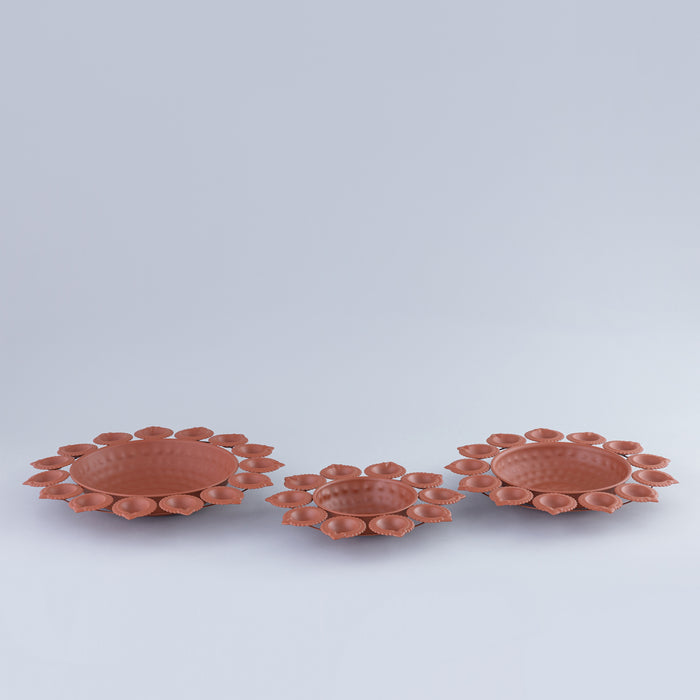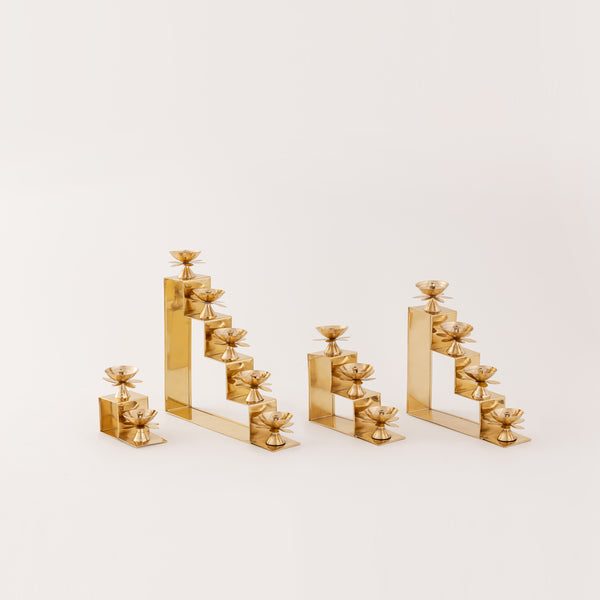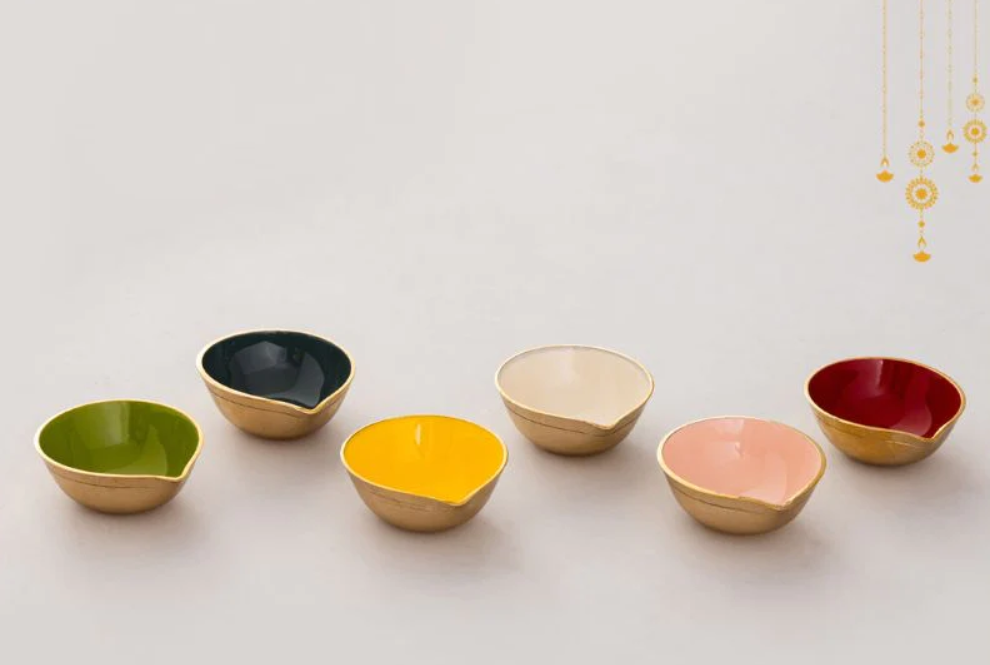Introduction
Diyas are traditional Indian lamps, typically made from clay, that play a central role in the country's rich cultural and spiritual tapestry. These small, oil-filled lamps have a cotton wick that is lit to produce a serene, flickering light. Historically, diyas were used as a primary source of light, but over time, their significance has transcended their functional use, embodying a deeper spiritual meaning.
In Indian culture, lighting a diya is synonymous with driving away darkness and bringing in light, which symbolizes the victory of good over evil, knowledge over ignorance, and hope over despair. This symbolism is deeply rooted in various Indian rituals, religious ceremonies, and festivals.
Beyond Diwali, diyas are a constant in many other Indian festivals and religious occasions, reflecting the belief that light is a harbinger of positivity and auspiciousness. Whether adorning a humble abode or a grand temple, the diya remains a powerful symbol of unity, purity, and hope in Indian culture.
What Is a Diya?
A Diya, often called a 'deepa' or 'deepam', is a traditional Indian lamp, deeply ingrained in the country's history and culture. Originating from the Sanskrit word 'deep', meaning light or lamp, the diya has been a part of Indian tradition for centuries, possibly dating back to the Indus Valley Civilization. Historically, diyas were used for lighting purposes, especially in the days before electricity. Their presence in ancient texts and rituals highlights their significance in religious and cultural ceremonies, symbolizing the removal of spiritual darkness and the ushering in of divine knowledge.
Materials and Traditional Designs

Traditionally, diyas are made from clay, shaped into a small bowl to hold oil, usually ghee or vegetable oil, with a cotton wick that burns to emit light. During religious festivals like Diwali, these clay diyas are often decorated with vibrant colors, intricate designs, and sometimes adorned with sequences, beads, or mirrors to enhance their aesthetic appeal.
However, the evolution of time has seen diyas being made from various other materials, including brass, copper, silver, and even gold for more affluent or ceremonial use. The designs also vary, ranging from simple, plain styles to more elaborate ones, often reflecting local artistry and cultural influences. Despite these variations, the quintessential image of a burning diya remains a potent symbol of hope, purity, and the triumph of light over darkness in Indian culture.
The Cultural Significance of Diyas in India

In India, the diya is not just a mere object; it's a sacred symbol deeply woven into the fabric of daily life and spirituality. The lighting of a diya is a ritualistic act performed during daily prayers (puja) in many Indian households. This ritual, known as 'deepa jyoti parabrahma', signifies the divine as the source of all knowledge and the remover of ignorance. The light from the diya is said to represent the spiritual purity and wisdom that dispels the darkness of the material world. In many spiritual traditions within India, including Hinduism, Buddhism, and Jainism, the diya symbolizes the light within oneself, encouraging introspection and the pursuit of truth.
Diyas in Festivals - Diwali and Beyond
Diyas take on a special significance during Indian festivals, most notably Diwali, the Festival of Lights. This auspicious occasion celebrates the victory of light over darkness, knowledge over ignorance, and good over evil. Homes, temples, and streets are adorned with rows of diyas, creating a magical and welcoming atmosphere. The lighting of diyas during Diwali is believed to invite the presence and blessings of Lakshmi, the goddess of wealth and prosperity.
Beyond Diwali, diyas are integral to other festivals and celebrations as well, such as Karthikai Deepam, celebrated in South India, where lamps are lit to ward off evil forces. They are also used during Navaratri, Ganesh Chaturthi, and other religious events, each with its unique significance and traditions. In every instance, the diya stands as a symbol of hope, unity, and the enduring power of light.
The Art and Craftsmanship of Diya Making
The art and craftsmanship of diya making are rooted in a rich tradition of pottery and artisanal skills passed down through generations in India. This craft involves a deep understanding of materials and a delicate touch to shape and decorate each piece, making it not just a functional item but also a work of art.

Handcrafted Clay Diyas
Handcrafted clay diyas remain a cherished tradition in India, symbolizing the country's rich heritage and the artisans' skillful craftsmanship. These diyas, shaped from natural clay, are often made in small, family-run workshops or by local artisans in rural areas. The process begins with the extraction of fine-quality clay, which is then molded by hand or on a potter's wheel to form the diya's classic, concave shape. After air drying, they are either left in their natural state or are hand-painted in bright colors and adorned with traditional patterns. The charm of handcrafted clay diyas lies in their simplicity and the subtle variations that come from being shaped by human hands. Each diya, with its slight imperfections and unique character, tells a story of tradition and artistry.
Modern Variations and Styles
In recent times, the humble diya has seen a transformation, adapting to modern tastes while retaining its cultural essence. Contemporary diyas come in various materials like terracotta, ceramic, metal, and even eco-friendly options like biodegradable materials. These modern variations are often more durable and come in a range of designs from minimalist to ornate. Some feature intricate carvings, innovative shapes, and embellishments like gold and silver foiling, adding a touch of luxury. Designers are also infusing contemporary art into diya making, creating pieces that are not just functional but also decorative art objects. These modern diyas cater to a global audience, appealing to those who seek a blend of traditional and contemporary aesthetics in their festival celebrations and home decor.
The Symbolism of Light in Diyas

Light as a Metaphor in Indian Philosophy
In Indian philosophy, light is a powerful metaphor representing knowledge, purity, and the divine. The diya, as a source of light, symbolizes the illumination of the mind and soul. It is seen as a means to dispel the darkness of ignorance and awaken the inner light of understanding and wisdom. This metaphor is deeply ingrained in various Indian scriptures and philosophies, where light is equated with the ultimate truth and the essence of the universe. Lighting a diya is thus not just a physical act but also a spiritual one, signifying the quest for truth and the dispelling of ignorance through knowledge and enlightenment.
Diyas as a Symbol of Hope and Goodness
Diyas are also symbolic of hope, goodness, and the enduring human spirit. In times of darkness or uncertainty, the act of lighting a diya can be a powerful gesture of optimism and faith. It represents the belief that light will always prevail over darkness and that goodness will ultimately triumph over evil. This symbolism is particularly evident during festivals like Diwali, where the lighting of diyas signifies hope, renewal, and the celebration of life. The diya's gentle glow is a reminder of the power of positivity and the ability of light, both literal and metaphorical, to guide and uplift.
Diyas in Contemporary Indian Decor

Incorporating Diyas in Modern Home Decor
In modern home decor, diyas have transcended their traditional role, becoming a stylish accessory that adds warmth and character to contemporary spaces. Interior designers and homeowners are creatively incorporating these lamps to blend tradition with modern aesthetics. Diyas are no longer restricted to religious or festive use; they are now a part of everyday decor, used to create a cozy, welcoming atmosphere. Placed in clusters on coffee tables, as centerpieces on dining tables, or lined along pathways and entryways, they add a touch of elegance and an ambient glow. Modern diyas come in various designs, from minimalist ceramic pieces to ornately decorated brass lamps, offering versatility to match any decor style. They can also be used in outdoor spaces like balconies and gardens, providing a serene and inviting ambiance.
Diyas as Gifts - A Tradition of Sharing Light
Gifting diyas is a deeply rooted tradition in Indian culture, symbolizing the sharing of light and warmth. During festivals, especially Diwali, it's customary to exchange beautifully crafted diyas among friends and family, as a gesture of goodwill and affection. This tradition extends beyond religious connotations; it's a way of wishing prosperity, happiness, and enlightenment to the recipient. In recent times, artisanal diyas, often accompanied by scented oils or designer matches, have become popular as thoughtful and sophisticated gifts. These modern interpretations of the traditional diya not only serve as a functional gift but also as a piece of art, reflecting the giver's taste and the bond they share with the receiver.
Reserving the Tradition - Diyas in the Modern World

Reviving Ancient Techniques
In an era where modernity often overshadows tradition, there's a growing movement to revive ancient diya-making techniques. Artisans and cultural enthusiasts are working to preserve the traditional methods of crafting diyas, which involve hand-picking the right type of clay, molding it by hand or on the potter’s wheel, and then firing it in a kiln. These methods are not just about producing a product; they are about keeping alive a skill that has been part of Indian culture for centuries. Workshops and educational programs are being organized to teach these skills to new generations, ensuring that the knowledge and heritage don’t fade away. By reviving these techniques, there is a renewed appreciation for the craftsmanship and the cultural significance behind each diya.
The Role of Diyas in Contemporary Cultural Practices
Diyas continue to play a significant role in contemporary cultural practices in India. Beyond their use in traditional festivals and rituals, they are now part of many modern ceremonies and celebrations, including weddings, inaugurations, and even corporate events. They are seen as a symbol of auspiciousness and are used to create an atmosphere of reverence and purity. Modern interpretations of these ceremonies often blend traditional practices with contemporary aesthetics, where diyas are used not only for their symbolic value but also as a means to add beauty and elegance to the occasion. The adaptability of diyas in various settings and their ability to resonate with both traditional and modern sensibilities underscore their enduring relevance in contemporary Indian culture.
Conclusion:
In conclusion, the diya, a humble traditional lamp, holds profound significance in Indian culture, embodying the timeless values of light, wisdom, and hope. Its journey from being a simple clay lamp to an object of artistic expression and cultural reverence reflects the rich tapestry of Indian traditions and the enduring nature of its cultural symbols. In contemporary times, the diya has seamlessly integrated into modern lifestyles, proving its adaptability and relevance in a rapidly changing world.

